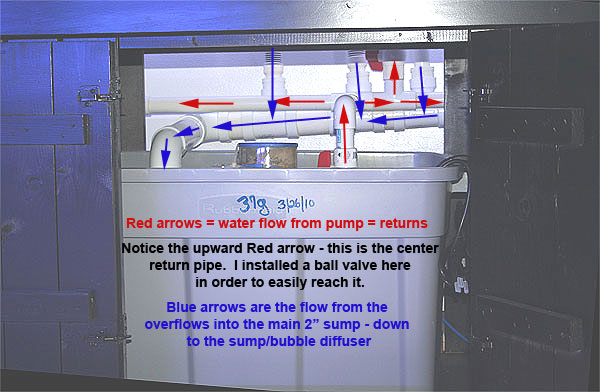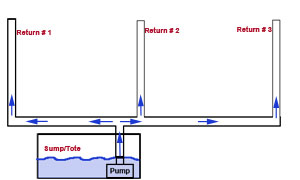
Under Cabinet Plumbing
Whether a 75g tank, 120g or 220g etc., all will be plumbed the exact same way.
This is Jay's 210g plumbing. It goes to a sump in his basement but could easily divert to a sump under the cabinet as shows in the next pic below this.
Smaller PVC pipe is 1" & is the return from the pump.
Larger 2" PVC pipe is the dump from the overflow box sets which connect via 2" PVC drain T's - slightly pitched down as this is a gravity feed dump. Note ... be sure your drain T's are all facing the same & right direction to the sump! :c)
The grey colored PVC pipe off the bottom of the overflows are PVC cemented into the top of the 2" drain T's which have a 1.5" to 1" reducer PVC cemented in them.
The picture below is showing you the sump & plumbing for a large 220g tank using a submersible pump. Again, the pump plumbing would be the same for a 75g & up. For this article, focus on the RED arrows which are the water flow coming from the submersed pump up & through the split return PVC pipes. Pictured below the pump uses 1" PVC pipe (again, noted with red arrows).

To plumb a submersible pump I set the pump physically inside the sump - as far to one end of the sump I can get it. This is to keep the pump away from the bubble making area which will be your bubble diffuser & skimmer area which should be located on the opposite end of your sump! Be sure to position it so it can freely intake water! Give the pump intake a few inches away from any obstruction like your sump wall.
For both submersible & external pumps: Depending on the discharge connector type on your pump (some have internal threads or external threads) you will need to end up with a fitting that is a slip end to install your first piece of straight PVC pipe. Internal thread will need a female PVC adapter which should be secured with aquarium sealer or GE 100% silicone (do not use other sealers as they contain harmful chemicals!). If an external thread, use a male PVC adapter. You can also use a PVC union to easily remove your pump from the plumbing pipes when service is needed. Next, you will install your main discharge ball valve so figure out where you want your ball valve located & cut your straight PVC pipe to the length to achieve this. Once the ball valve is in you will use another straight piece of PVC pipe to connect to a 90 degree elbow to turn the water flow to the back of your tank. The next piece of straight PVC pipe will end with a PVC "T" connected at the end so the water flow will be split into 2 streams (flowing left & right) horizontally behind your tank. You will need to install another "T" as close to the center of your tank as possible to create a center "Return" for the tank. Then you will continue on both left & right with straight PVC until you reach both tank ends where you will install a 90 degree PVC elbow to turn the water flow up/vertical. At the top of both these elbows you will install a PVC reducer to decrease the PVC pipe size. Example: Starting with 1 inch PVC from the pump we will reduce to 3/4". Starting with 1.5" will reduce to 1" etc.
The vertical return plumbing - we need to install a ball valve on all 3 returns (note the red handle in the picture). This will allow us to control how much water is coming out of them. Understand that the closest return to the pump will receive the strongest water flow so it's important to have control over the flow & reduce or increase as needed by opening or closing a return valve. Note: I like to install my center ball valve down low to the sump area (seen in the top pic here) as I find it difficult to reach it over the tank top! Once set at a flow rate you want we rarely have to adjust them again so no worries!
When the outside of tank plumbing is done it will flow like this...
Next ... Building the "inside tank" portion of the "Returns". Click here for a printable "Parts List" & diagram.




